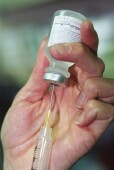- Navigating Your Midlife Crisis: Embracing New Possibilities
- City Raccoons Showing Signs of Domestication
- Mapping the Exposome: Science Broadens Focus to Environmental Disease Triggers
- One Week Less on Social Media Linked to Better Mental Health
- Your Brain Changes in Stages as You Age, Study Finds
- Some Suicide Victims Show No Typical Warning Signs, Study Finds
- ByHeart Formula Faces Lawsuits After Babies Sickened With Botulism
- Switch to Vegan Diet Could Cut Your Greenhouse Gas Emissions in Half
- Regular Bedtime Does Wonders for Blood Pressure
- Dining Alone Could Mean Worse Nutrition for Seniors
Disease Outbreaks May Not Change Minds of Vaccine Opponents


Health experts who hope that outbreaks of childhood illnesses might spur vaccine-refusing parents to change their stance may be discouraged by results of a large new study.
During an outbreak of whooping cough (pertussis) in Washington state lasting from October 2011 through December 2012, the researchers found that vaccination rates did not rise.
Among some 80,000 infants aged 3 months to 8 months, the research team looked at how many received the recommended number of doses of diphtheria, tetanus and pertussis vaccine (DTaP) — the current vaccine against whooping cough — before and during the epidemic.
“We found that compared to a point in time before the epidemic, there was no significant increase in receipt of whooping cough vaccine for infants during the epidemic,” said lead researcher Dr. Elizabeth Wolf. She is a senior fellow at the Seattle Children’s Research Institute, affiliated with the University of Washington.
The new study comes amid recent reports that outbreaks of preventable childhood illnesses — such as whooping cough and measles — are on the rise.
Meanwhile, controversy over vaccination safety remains as some parents continue to opt out of mandated childhood immunizations through “personal belief” exemptions, although some states are taking steps to limit these exemptions.
“Vaccination rates in the U.S. are still below public health goals,” Wolf said. “We don’t fully understand what improves vaccine acceptance.”
Wolf added that one conventionally held belief is that when the risk of disease is high, acceptance of a vaccine increases if it’s effective at preventing the disease. “Our study challenges this assumption that vaccine acceptance uniformly increases when risk of disease is high,” she said.
Another expert said that parents choosing not to vaccinate their children is likely the primary cause of outbreaks of diseases that had all but disappeared in the United States.
“The problem is not theoretical,” said Dr. Paul Offit, chief of the division of infectious diseases at the Children’s Hospital of Philadelphia. “You are starting to see eroding of herd immunity with outbreaks of measles and pertussis. The main reason is people are choosing not to vaccinate their children.
“It’s becoming a more dangerous world from the standpoint of infectious diseases. Measles and pertussis are back. These are serious diseases that before vaccine caused a lot of death,” he added.
Vaccination is the best protection against these diseases, and choosing not to have children vaccinated can be risky, Offit said. “It’s a dangerous game to play and there is no upside to not giving the vaccine — it’s a game of Russian roulette,” he said.
The main fear parents have is that vaccines somehow increase the odds of their child developing autism, Offit noted. Although the connection between autism and vaccines has been discredited, it still lingers.
Now, he said, “Until we can find a clear cause or causes of autism, or cure or preventive for autism, the fear of vaccination is going to be there. It’s very easy to scare people, it’s really hard to un-scare them.”
Meanwhile, infectious diseases will continue to spread.
Whooping cough is an extremely contagious bacterial disease that can lead to pneumonia, seizures, brain damage and death, and it hits babies the hardest, the researchers say.
Babies who received at least one dose of the DTaP vaccine by 3 months of age, at least two doses by 5 months and at least three doses by 7 months are considered up to date by the CDC’s advisory committee on immunization practices.
The DTaP vaccine is well established with very few side effects, but it is possible that parents may have concerns about vaccine safety, Wolf noted.
“It is unclear why there was no significant increase in vaccination during the epidemic,” she said. “We don’t know if parents’ fear of adverse events still outweighed the fear of disease, even in the face of the epidemic.”
The results of the study were scheduled to be presented Monday at the meeting of the Pediatric Academic Societies in Vancouver, British Columbia. The data and conclusions should be viewed as preliminary until published in a peer-reviewed journal.
Before the 1940s when the vaccine became available, about 200,000 Americans suffered from whooping cough each year and about 9,000 died, according to the U.S. Centers for Disease Control and Prevention.
The agency notes that in 2012, whooping cough made more than 48,000 people sick and caused the death of at least 14 babies younger than 3 months.
Dr. Greg Wallace of the CDC said that family doctors are the key to getting kids vaccinated.
“Even though health care providers are being strapped more for time, our experience has been that most parents still listen to their primary care providers,” he said.
“If they provide the information and answer parents’ questions and still champion the vaccine, that’s usually the most effective way to get people vaccinated,” added Wallace, who is the CDC’s team leader for measles, mumps, rubella and polio.
For his part, Offit said that the success of vaccines has lulled people into a false sense security. Since many of these diseases have all but disappeared, people have forgotten how horrible they were, he said.
Offit’s prescription for getting more kids vaccinated is a harsh one. “I guess more children have to suffer, be hospitalized or die before parents consider them to be at risk,” he said.
More information
To learn more about vaccinations, visit the U.S. Centers for Disease Control and Prevention.
Source: HealthDay
Copyright © 2025 HealthDay. All rights reserved.










